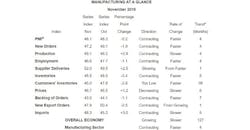Economic activity in the manufacturing sector contracted in November, and the overall economy grew for the 127th consecutive month, say the nation’s supply executives in the latest Manufacturing ISM Report On Business.
“Comments from the panel were consistent with the previous month, with sentiment improving compared to October,” said Timothy R Fiore, chair of the ISM Business Survey. “November was the fourth consecutive month of PMI contraction, at a faster rate compared to the prior month. Demand contracted, with the New Orders Index contracting faster, the Customers’ Inventories Index remaining at ‘too low’ levels and the Backlog of Orders Index contracting for the seventh straight month (and at a faster rate). The New Export Orders Index returned to contraction territory, likely contributing to the faster contraction of the New Orders Index.
“Consumption (measured by the Production and Employment indexes) contracted, due primarily to lack of demand, but contributed positively (a combined 1.8-percentage point increase) to the PMI calculation. Inputs—expressed as supplier deliveries, inventories and imports—were again lower in November, due primarily to contraction in inventories that was partially offset by supplier deliveries returning to ‘slowing.’ This resulted in a combined 0.9-percentage point decrease in the Supplier Deliveries and Inventories indexes.”
The November PMI registered 48.1%, a decrease of 0.2 percentage point from the October reading of 48.3%.
Other highlights from the report:
- The New Orders Index registered 47.2%, compared to the October reading of 49.1%.
- The Production Index registered 49.1%, compared to the October reading of 46.2%.
- The Backlog of Orders Index registered 43%, compared to the October reading of 44.1%.
- The Employment Index registered 46.6%, compared to the October reading of 47.7%.
- The Supplier Deliveries Index registered 52%, compared to the October reading of 49.5%.
- The Inventories Index registered 45.5%, compared to the October reading of 48.9%.
- The Prices Index registered 46.7%, compared to the October reading of 45.5%.
- The New Export Orders Index registered 47.9%, compared to the October reading of 50.4%.
- The Imports Index registered 48.3%, compared to the October reading of 45.3%.
“Imports contraction softened,” Fiore said. “Overall, inputs indicate (1) supply chains are meeting demand and (2) companies are less confident that materials received will be consumed in a reasonable time period. Prices decreased for the sixth consecutive month, at a slower rate.”
Miscellaneous manufacturing was among five industries reporting growth in November. Fabricated metal products, transportation equipment, primary metals and machinery were among 13 industries reporting contraction.
“Global trade remains the most significant cross-industry issue,” Fiore said. “Among the six big industry sectors, Food, Beverage & Tobacco Products remains the strongest, while Fabricated Metal Products is the weakest.
“Overall, sentiment this month is neutral regarding near-term growth.”
Here are some selected comments from respondents:
- “Business level is similar to October.” (Computer & Electronic Products)
- “Chemical industry has been slow globally, but the curve seems to be flattening.” (Chemical Products)
- “Economic uncertainty continues. Our outlook on future business is cautious, yet positive.” (Transportation Equipment)
- “Economy is holding up. Business is staying constant. The same challenges persist—foreign exchange, trade uncertainty and trend changes [for example, sugar reduction].” (Food, Beverage & Tobacco Products)
- “Slowdown in business has us revising our 2020-21 capital spend.” (Petroleum & Coal Products)
- “The order book continues to shrink below our forecast levels. We’re unsure at this point how much of the slowdown is tied to certain events [like the General Motors strike], year-end inventory reductions by customers, or a worsening economy. We don’t expect clarity on this until early 2020, when we expect to either see restocking orders [a good sign] or not [a bad sign].” (Fabricated Metal Products)
- “Demand has stabilized for the last half of [the fourth quarter], and production will be stable for the rest of this year.” (Machinery)
- “Heading into the holiday season, we are seeing the backlog decrease as new orders for 2020 seem lighter than in past years.” (Plastics & Rubber Products)
- “Markets have downshifted further. The continued confusion surrounding China trade has kept export markets on edge. Profits are elusive. Cash-flow planning is paramount. The general economy is slowing down.” (Wood Products)
- “Incoming orders and production have ticked back up. Tariffs are still a question.” (Furniture & Related Products)

